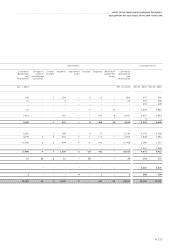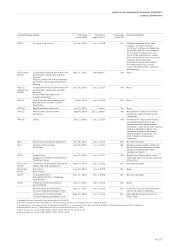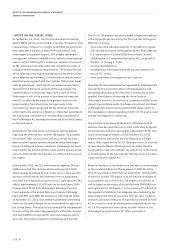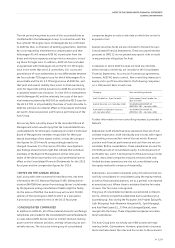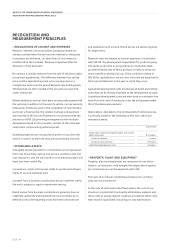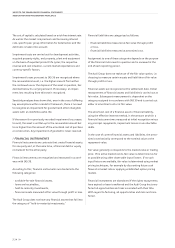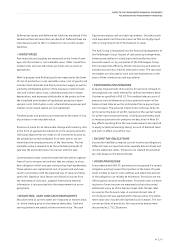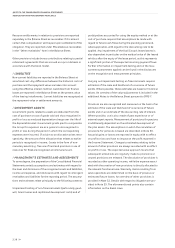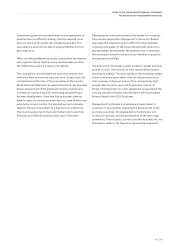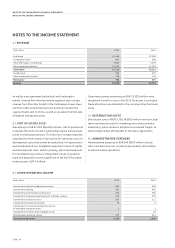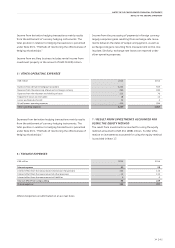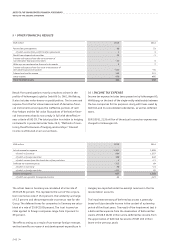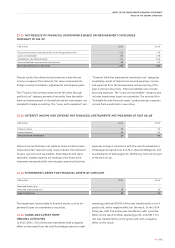Audi 2015 Annual Report Download - page 235
Download and view the complete annual report
Please find page 235 of the 2015 Audi annual report below. You can navigate through the pages in the report by either clicking on the pages listed below, or by using the keyword search tool below to find specific information within the annual report.
NOTES TO THE CONSOLIDATED FINANCIAL STATEMENTS
RECOGNITION AND MEASUREMENT PRINCIPLES
>> 235
Financial assets and liabilities are only offset if offsetting the
amounts is legally enforceable at the current time and if there
is an actual intention to offset. As a general rule, no financial
assets and liabilities are offset within the Audi Group due to the
required conditions not being met. Given the general lack of
any global offsetting agreements or similar arrangements, it is
also not possible to carry out offsetting under certain conditions.
Financial assets and liabilities include both non-derivative and
derivative claims or commitments, as detailed below.
// NON-DERIVATIVE FINANCIAL INSTRUMENTS
The “Loans and receivables” and “Financial liabilities measured
at amortized cost” categories include non-derivative financial
instruments measured at amortized cost. These include, in
particular:
>borrowings,
>trade receivables and payables,
>other current assets and liabilities,
>financial liabilities,
>cash and cash equivalents.
Receivables and liabilities in foreign currencies are measured
at the relevant year-end exchange rates.
In the case of current items, the fair values to be additionally
indicated in the Notes correspond to the amortized costs. For
assets and liabilities with a remaining term of more than one
year, fair values are determined by discounting future cash
flows at market rate. Recognizable credit risks associated with
“Loans and receivables” are accounted for by creating specific
allowances. These are entered in the amount of the incurred
loss for significant individual receivables using benchmarks
applied uniformly across the Group. Potential impairment is
assumed in the event of various circumstances such as a pay-
ment delay of a specific duration, introduction of coercive
measures, threat of insolvency or over-indebtedness, applica-
tion for or opening of insolvency proceedings or failure of
restructuring measures. Impairment losses on receivables are
regularly posted to separate impairment accounts and written
off at the same time as the corresponding impaired receivable.
The item “Available-for-sale financial assets” includes non-
derivative financial instruments that are either allocated to this
category or cannot be allocated to any of the other categories.
This includes equity instruments, such as shares in equity, and
debt instruments, such as bonds. As a general rule, financial
instruments that fall into this category are reported at fair
value. In the case of listed financial instruments – exclusively
securities in the case of the Audi Group – the fair value corre-
sponds to the market value on the balance sheet date. Fluctua-
tions in value are accounted for within equity in the reserve for
the fair value measurement of securities, taking deferred tax
into account.
“Available-for-sale financial assets” are impaired if there is
objective evidence of a long-term loss of value. In the case of
equity instruments, a permanent value reduction is deemed to
have occurred if the market value falls below the cost of pur-
chase on a significant basis (more than 20 percent) or on a
long-term basis (more than 10 percent of the average market
prices throughout a year). Debt instruments are impaired if
future payment flows from the financial asset are expected to
fall. Any rise in risk-free interest rates or credit spreads, how-
ever, does not constitute objective evidence of a loss in value.
As soon as impairment occurs, the difference between the cost
of purchase and fair value is posted under the financial result
with an effect on profit or loss. Any loss previously recorded in
the reserve for fair value measurement of securities, without
affecting profit or loss, is abandoned.
Reversals of impairments – provided that the securities affect-
ed are equity instruments – are recognized without affecting
profit or loss. If, on the other hand, the securities concerned
are debt instruments, impairment losses are reversed with an
effect on profit or loss (no higher than the previous impair-
ment amount) if the increase in the fair value, when viewed
objectively, is based on an event that occurred after the im-
pairment loss was recorded with an effect on profit or loss.
The category “Available-for-sale financial assets” comprises
securities. With effect from the 2015 fiscal year, interests in
non-consolidated subsidiaries and participations in associated
companies and joint ventures that are not valued according to
the equity method are no longer classed as financial instru-
ments. The disclosures on financial instruments pursuant to
IFRS 7 (including the previous year’s figures) were adjusted
accordingly. Other participations that do not fall within the
scope of IAS 28, IFRS 10 or IFRS 11 and are measured at their
respective amortized cost pursuant to IAS 39.46(c) are reported
in the category “Measured at fair value.”


